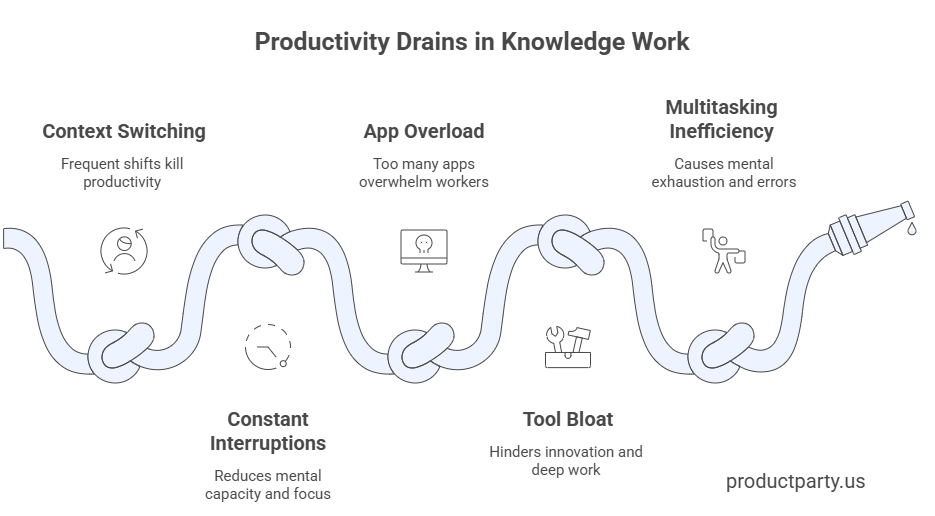The $18 million problem hiding in your tech stack.
How tool sprawl became the silent productivity killer that's costing organizations more than unused software licenses.
I was talking to a product manager last week who showed me their desktop. Seventeen browser tabs open. Four Slack workspaces. Two different project management tools. Three monitoring dashboards.
"I spend my first hour every morning just catching up," they said. "By the time I'm done checking everything, I've already context-switched myself into exhaustion."
They're not alone. Organizations are hemorrhaging $18 million annually on unused software, but that's just the visible cost.
The real damage happens to smart professionals who've been handed a productivity problem disguised as a productivity solution.
Why smart teams keep buying their way into chaos.
The math should be simple: more tools equals more capability. But we've created something closer to a digital hoarding problem. The average company now manages 275 SaaS applications, with engineering teams alone juggling 108 different tools.
Teams face a specific problem, find a tool that solves it, and adopt it without considering the broader ecosystem. Each decision makes perfect sense in isolation.
What’s the common result?
Developers lose 6-15 hours weekly just navigating between platforms. Product managers spend 1.8 hours daily hunting for information across disconnected systems.
We've built productivity quicksand.
The real cost isn't the subscription fees.
Think about the context switching penalty: knowledge workers toggle between applications 1,200 times daily, losing 9.5 minutes of productivity with each transition. University of California research shows it takes 23 minutes to return to the original task focus after an interruption.
For roles requiring deep focus, this creates a productivity death spiral. But here's what really bothers me about this situation: we're not just losing time, we're losing our capacity for the work that actually matters.
When you're constantly switching between tools, you're always operating in reactive mode. You never get to that flow state where your best thinking happens.
I've watched brilliant engineers spend more time configuring dashboards than building features. I've seen product managers become project managers because they're too busy coordinating tools to do strategic thinking.
The tools we adopted to make us more efficient have made us more administrative.
The hidden tragedy isn't just the wasted time - it's the wasted potential. Technical talent spends time on tool management rather than innovation. Product teams focus on managing their workflow instead of managing their products.
We've accidentally turned knowledge workers into digital janitors.

Your move in the tool sprawl game.
Product people are naturally positioned to lead these conversations. You already think in terms of user experience and workflow optimization. The difference is now you're optimizing for your own team's sanity instead of external users.
Here's the thing: you don't need executive buy-in to start. You just need curiosity and one willing teammate.
I've seen product managers create meaningful change by treating tool chaos like any other user experience problem - observe, hypothesize, test, iterate.
Map your team's tool ecosystem. Document every tool your team uses weekly. Ask them to add tools you missed. You'll discover shadow tools you didn't know existed.
Run a "tool archaeology" session. Schedule an hour where your team shares screens and walks through their actual workflow. Watch how many times they switch applications to complete a single task. This reveals the hidden friction everyone feels but rarely discusses.
Start with one painful handoff. Pick the most frustrating point where information gets lost between tools. Focus your consolidation experiment there first. Quick wins here build momentum for bigger changes.
When you demonstrate results on a small scale, you build credibility for larger changes.
More importantly, you'll have given your team something they didn't know they desperately needed: breathing room.
Final thoughts.
Tool sprawl isn't a technology problem; it's a decision-making problem. The most productive teams I know aren't using the newest tools.
They're using fewer tools that work better together.
What would your daily workflow look like if you could access everything you needed from three tools instead of thirteen?
Until next week,
Mike @ Product Party
Want to connect? Send me a message on LinkedIn, Bluesky, Threads, or Instagram.
P.S. Are you a founder looking for some direction on what to build next? Check out Product Party - The Founder Starter Pack. It’s perfect for first-time founders who want frameworks over philosophy, evidence over gut feelings, and practical templates over theoretical advice.




This is so important, Mike. Management can’t just send the typical survey to their employees with questions like “do you like AI tools?” More attention and a performance assessment is needed here.
Great points, as always!